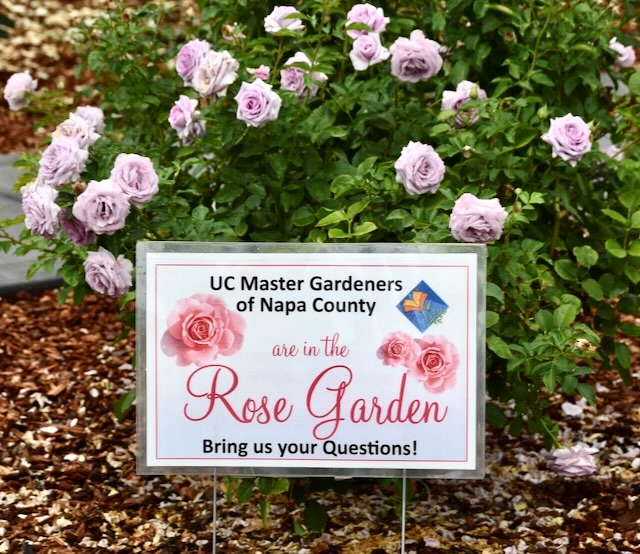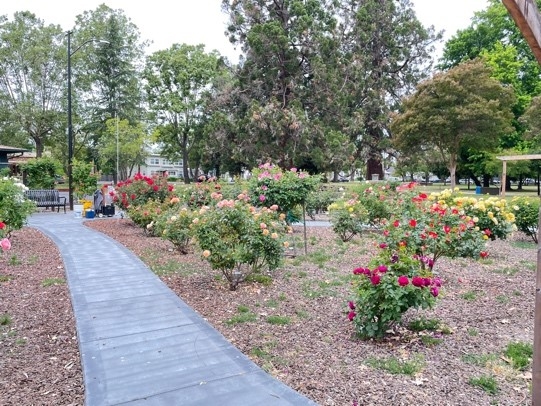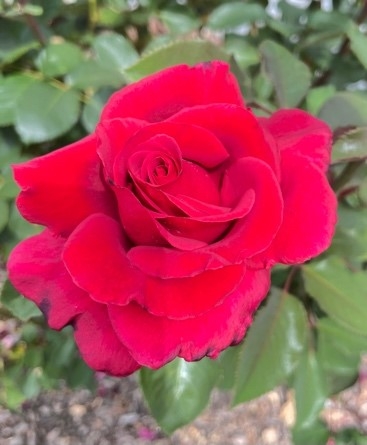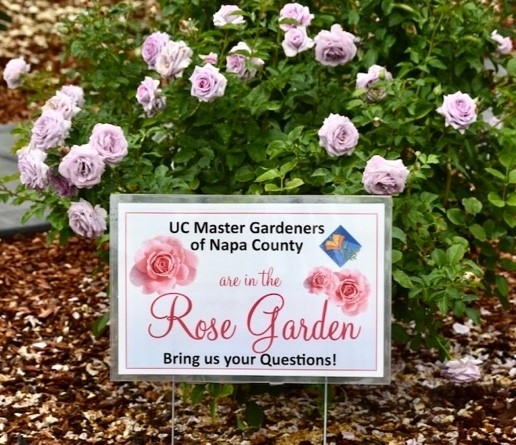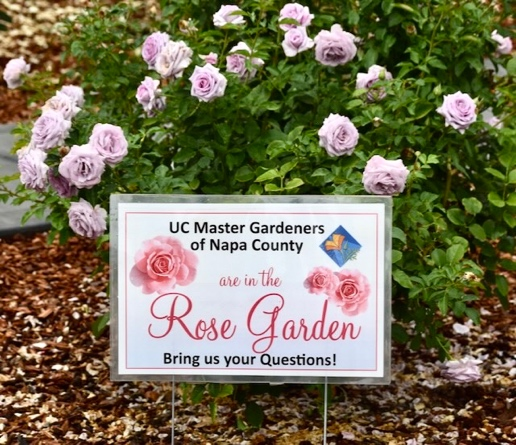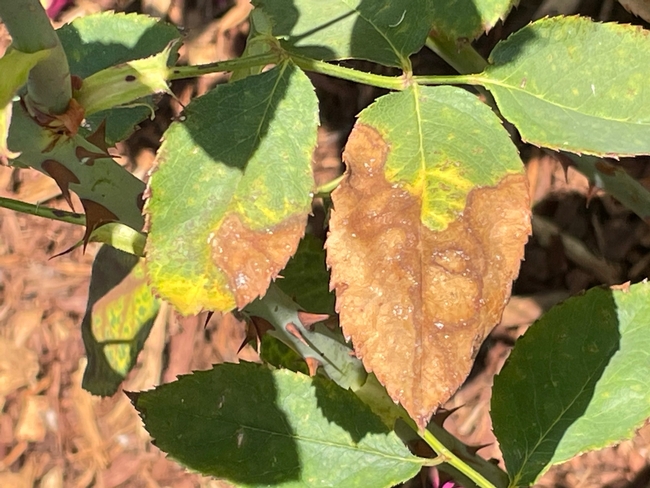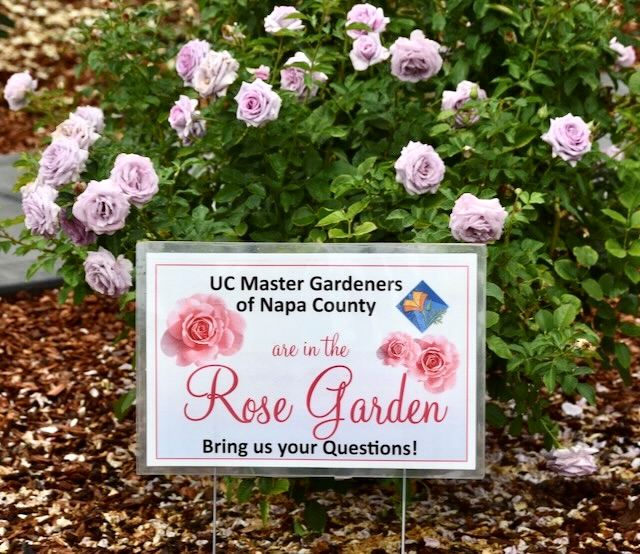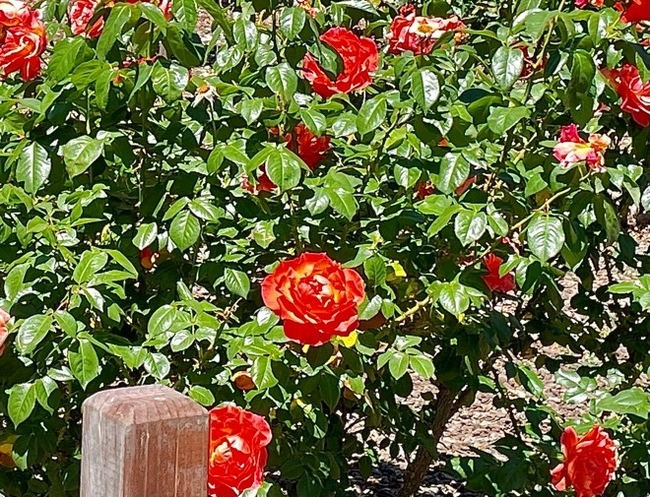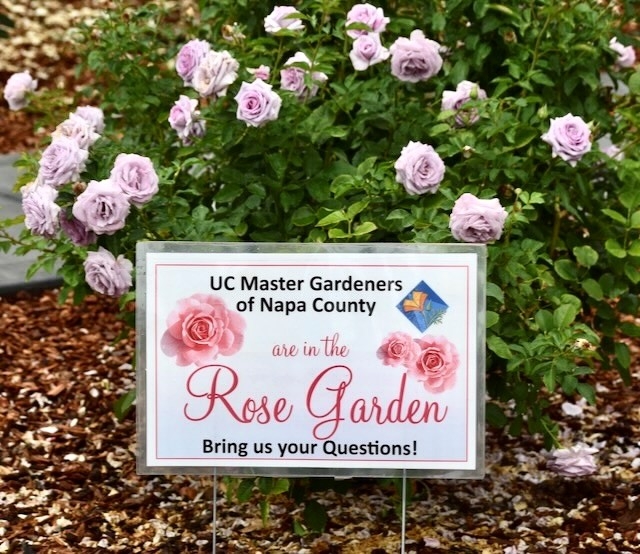- Author: Bob Niklewicz MG at the Fuller Park Rose Garden
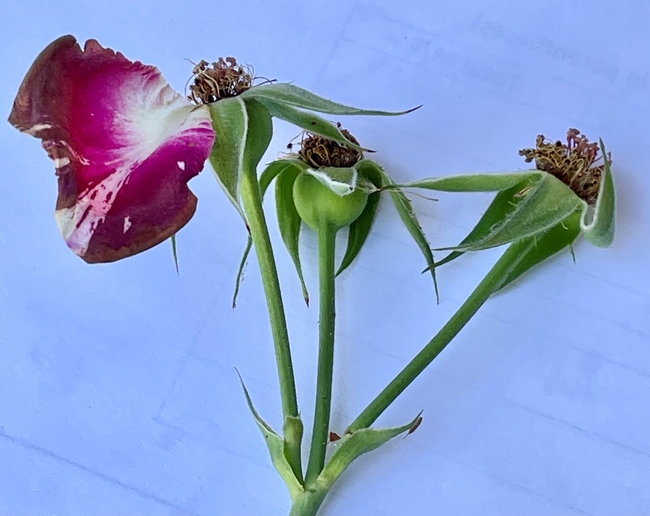
Most gardeners have a passing knowledge of the term “deadheading” as it pertains to roses or other flowering plants. It is the removal of the fading or dead flowers from a plant. The main reason for doing so is to keep the flowers blooming and the bushes looking clean and healthy, as well as preventing fungal infestation in the spring. These are the primary reasons we do deadheading in the Fuller Park Rose Garden. We are trying to keep the energy from the leaves and flowers from producing more new growth in the plant's cycle of life.
When our roses start to fade or just look sad, they grow seed pods called rose hips, and when they are swollen and fertilized (pollinated) they fall to the ground to reproduce copies of the parent bush in the wild. Or, they might be picked apart by birds that eat the seeds before they get anchored in the ground.
In controlled environments like our Napa gardens, we generally like to keep the beautiful flowers when they are in full bloom. In order to keep the blooms coming, we deliberately stop the life cycle by deadheading the blooms before the seed pod develops. When deadheaded, the plant will again spend energy to grow more seed pods (hips) in order to propagate themselves.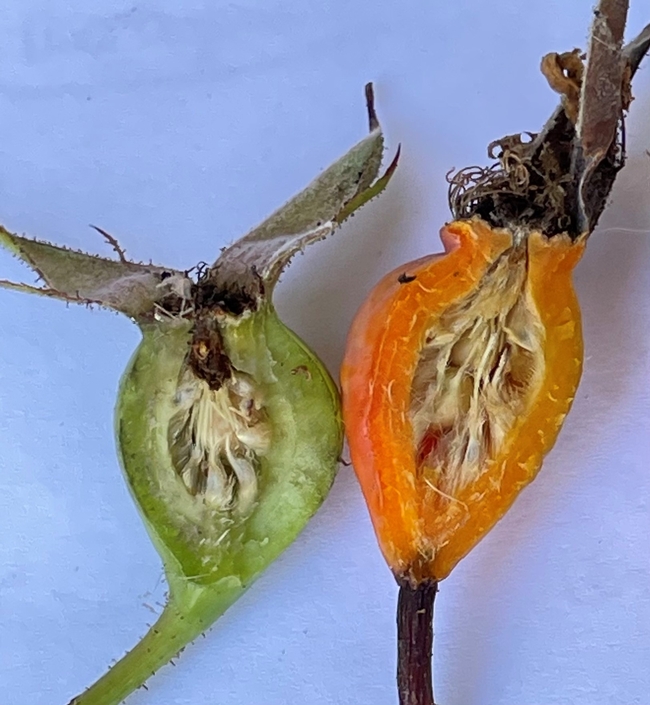
With some plants you can do the deadheading with just your fingers and thumb by pinching them off. This is an especially good technique for smaller, younger plants where you Pinch off the top growth in order to stimulate more branches. Roses, because of the thorns, should be pruned with scissors or shears. If you choose to just take off the rose blossom high on the stem, a finger pinch would work, too. With roses, use your shears and make your cut just above the next lower leaves that have five leaflets on it. If the flowers have been fairly large, you might consider going down to the second set of five leaflets. Make a clean cut just above the leaf.
When working with hybrid tea roses the above is the standard approach to deadheading. However, often you may find new “buds” coming up below the blossom. These are often disbudded (pinched off) in order to make the main blossom bigger. If you are to prune a floribunda variety of rose, often blooms are in clusters of 7-8 blossoms. Some will fade before the rest. You may just cut away the spent bloom so the others can have more space and energy to grow.
In Napa we have mild winters and roses might grow all year. In colder parts of the country rose bushes go dormant. In Fuller Park, we have an aggressive protocol in January where we can reduce the bushes heights as much as two thirds of their normal size. In essence, we are forcing dormancy by doing this, that will lead to wonderful blooms by May.
There will be a ZOOM course open to the public during the first week of January, followed by a hands-on class at the Fuller Park Rose Garden the following week. Watch the Master Gardener website ( https://napamg.ucanr.edu/ ) for more details if you wish to participate.
Remember: Toss plant debris into your city compost bin and NOT your own compost pile. The Napa City compost center produces high temperatures that destroy harmful spores while your backyard compost pile is unable to do so.
(Photo Credits Bob Niklewicz)
If you have questions about the Fuller Park Rose Garden and the Master Gardeners who maintain the Rose Garden, we are usually in the Garden the first Sunday and third Thursday of each month between 10:00 a.m. and 12:00 p.m., weather permitting, February through November. Thank you for your interest in the Fuller Park Rose Garden. See you there.
Napa Master Gardeners are available to answer garden questions by email: mastergardeners@countyofnapa.org. or phone at 707-253-4143. Volunteers will get back to you after they research answers to your questions.
Visit our website: napamg.ucanr.edu to find answers to all of your horticultural questions.
- Author: Bob Niklewicz, MG at the Fuller Park Rose Garden
The October Master Gardener's Rose Cycle chart (https://napamg.ucanr.edu/files/254549.pdf) has us continuing to deadhead and removing infected leaves that show yellowing, black spots, browning edges and/or have pests lurking among the blossoms and stems. The blossoms are coming slower and in fewer numbers. Enjoy what is out there for the next couple of months.
Many of our bushes have suffered from the elevated heat, and diminished watering. Leaves have turned brown, look wilted and/or just fell off to preserve the moisture in the bush. Many leaves look dull and are no longer glossy. Don't be surprised or feel bad that the rose garden has the same problems you have in your yard. This too, is part of the rose cycle and nature.
Now is the time to handle the heat issues and to watch out for signs of delayed heat stress that caused the leaves to yellow or be susceptible to black spots and pests. Pick off those infected leaves that haven't fallen off the branches as well as those that are on the ground and put them in the city compost bins to reduce the spread of fungus. Remember to sterilize your pruners after each bush to reduce the spread of the black spots.
Keep watering the bushes a couple of times a week with about a gallon per plant during these cooler days. If we do get another hot period, add another day of watering.
The bushes will be starting to store nutrients in the roots for the winter. The last dose of organic fertilizer should have already been done, but if it hasn't, follow the dosing instructions on the packages and do it now.
ROSE of the MONTH: 'Firefighter'
The 'Firefighter' is a very popular rose in our garden. It is a hybrid tea with wonderful full and dark red blooms. It is great for cuttings with a wonderful fragrance. Though it is supposed to be thornless, it still gets some. It is disease resistant and a rose with a classic look.
It can grow to 6' tall if you let it and easily 3-4' across. It does great in our Zone 9 climate.
Remember when pruning to toss that plant debris into your city compost bin and not your own compost pile. The Napa City compost center produces higher temperatures to destroy the spores while your backyard pile will not do so. When it comes time to add mulch, consider getting it from the Napa Recycling & Composting Facility.
If you have questions about the Fuller Park Rose Garden and the Master Gardeners (MGs) who maintain that Rose Garden, the MGs are usually in the garden the first Sunday and third Thursday of each month between 10:00 and 12:00, weather permitting.
Napa Master Gardeners are available to answer garden questions by email: mastergardeners@countyofnapa.org. or phone at 707-253-4143. Volunteers will get back to you after they research answers to your questions. You can also go to our Master Gardener website: napamg.ucanr.edu for more details.
Photos by Bob Niklewicz
- Author: Bob Niklewicz, MG at the Fuller Park Rose Garden
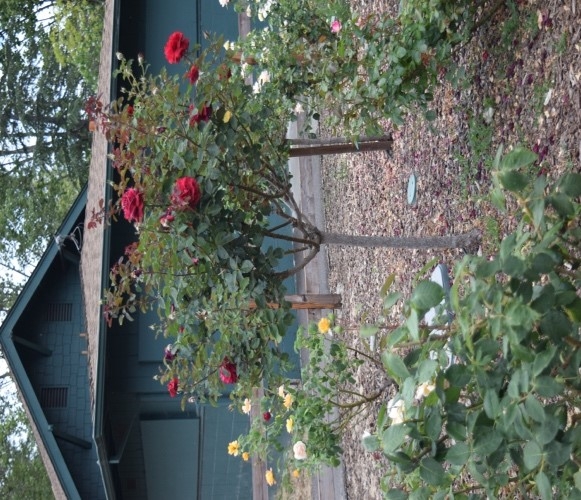
We had a tremendous amount of heat in July and August. Many of our bushes suffered greatly from heat stress. Leaves turned brown, looked wilted and/or just fell off to preserve the moisture in the bush. Extra watering or, better yet, more frequent watering to keep the root ball moist is like CPR.
Leaves will also turn yellow from the heat or be susceptible to black spots. Pick those off the branches and off the surrounding ground to reduce the fungus from spreading. Remember to sterilize your pruners after each bush to reduce the spread of the black spots. Note: We are not totally past severely hot days this summer; protect your roses. Even putting a cover/shade or umbrella over them during the hottest part of the day will save them from the worst part of the heat.
You may also see aphids now. For the majority of cases, just using a high pressure hose spray will wash off those soft bodied pests. Do it every couple of days until the problem is reduced greatly or cleared. Also, make sure your irrigation systems is working correctly so that your plants receive proper moisture.
Rose of the Month: Angel Face
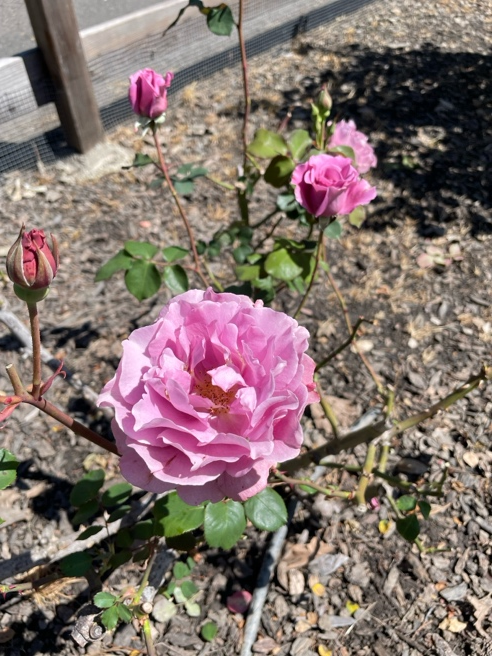
Remember when pruning: Toss plant debris into your city compost bin and not your own compost pile. The Napa City compost center produces higher temperatures to destroy the spores while your backyard pile will not do so. When it comes time to add mulch, consider getting it from the Napa recycling center.
If you have questions about the Fuller Park Rose Garden and the Master Gardeners (MGs) who maintain the rose garden, we are usually in the garden the first Sunday and third Thursday of each month between 10:00 and 12:00, weather permitting.
You can also go to our Master Gardner website: napamg.ucanr.edu for more details.
Napa Master Gardeners are available to answer garden questions by email: mastergardeners@countyofnapa.org. or phone at 707-253-4143. Volunteers will get back to you after they research answers to your questions.
- Author: Bob Niklewicz , MG in the Fuller Park Rose Garden
It has been a great summer, the monster rainfall of this past winter and spring a distant memory, and the yard looks wonderful in May and June. You are pumped up about how well your gardening skills have developed. You are getting a sore shoulder from patting yourself on the back in celebration of the glory of your garden. –You smile to yourself and kickback on your rose care diligence. “Where is my wine?” Then July rolled around. Your “wining” has turned to “whining.” “What happened to my roses? The leaves have turned brown and they look awful.”
Well, you are human, you think when you fix something in the garden, it stays fixed. Well, you are wrong, Buttercup. Mother Nature lives in your yard too. In July she said, “It is time for a little humility for our green-thumbed person. I think I will cook their plants.” What happens when it turns from spring weather to Death Valley weather in your Napa garden? Cooked plants happens. This dose of truth from Mother Nature may hurt, especially when it catches you off guard, even for a day or two. This is the deal, roses do like 6-12 hours a day of normal sunlight–the key word being normal. Roses can take pretty much any amount of sun, but when it gets into the 85-90's things change. It gets even worse if you have some of your roses in containers like I do; you have to be ready for the heat beforehand. You avoid gophers with containers (gopher issues are fodder for another column) but encourage irrigation issues. If you guess wrong, you will find:
#1 Wilting is the first sign of heat stress. It shows up in the older leaves first near the top of the plant. It is a normal protective reflex of the rose to wilt/curl their leaves to preserve moisture. If you have a drip system on a timer, but you have not adjusted for the hotter days, you will get wilting and dropping of leaves sooner as the root ball is probably too dry and water will not penetrate to the drying roots. When the roses start to wilt, they also become susceptible to diseases too. Black spot, rust, and other fungal infestations can attack the leaves. Even spider mites or scale can take advantage of the problem. Deal with these threats quickly or you can lose all the leaves which will take weeks to regrow.
#2 Browning of edges as the picture above shows, the edges / tips turn brown. It is a different brown than fungal infestation; it is clearly a leaf that is baked. You have to remove these as they will not come back. Soak the root ball and make sure that it does not dry out again. Spray the leaves as needed. Use a meter if necessary. If the rose is in a container, you may have to soak the whole container into a tub filled with water, to fully rehydrate the ball–don't drown the ball, just get it thoroughly wet. If it is too big to lift of move, run a hose at a low rate into the container until it is saturated. If the ball is in the ground, using a shovel or trowel to loosen the soil will help get the water down deeper.
#3 Cover if possible when it gets over 95 degrees, placing a cover, shade cloth or umbrella over the plant. This is needed as the bush will no longer be able to go through photosynthesis and it no longer can efficiently respire. Blooms stop or become smaller, the leaves weaken and evaporation through transpiration speeds up and recovering from wilting becomes less likely.
#4 Mulch: If the damage is done or if you are ahead of the problem of heat stress, you should consider mulching. A layer of mulch about 2-3” thick around the plant will protect the bush. This will protect the root ball from the drying effects on the soil and prolong the retention of what water is available. The mulch will hold water between watering cycles and it will reduce the amount of weeds below the plant. Using a moderate spray of water in the mornings will get the bush ready for a hot day, but it will also remove dust as well as pests from the plants. In normal weather situation, it is not recommended to spray the leaves of roses due to fungal disease issues. However, in the scorching hot days, keeping the leaves cool is the lesser of two evils. 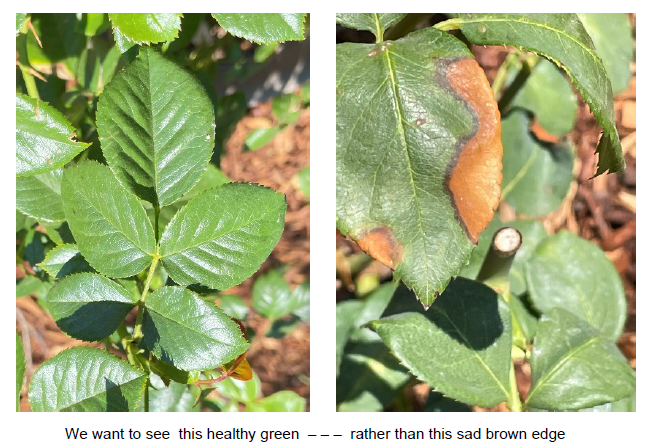
Remember to toss plant debris into your city compost bin and not your own compost pile. The Napa City compost center produces higher temperatures to destroy the spores while your backyard pile will not do so. When it comes to add mulch, consider getting it from the Napa recycling center.
If you have questions about the Fuller Park Rose Garden and the Master Gardeners (MGs) who maintain that Rose Garden, the MGs are usually in the garden the first Sunday and third Thursday of each month between 10:00 and noon, weather permitting.
Napa Master Gardeners are available to answer garden questions by email: mastergardeners@countyofnapa.org. or phone at 707-253-4143. Volunteers will get back to you after they research answers to your questions.
Visit our website: napamg.ucanr.edu to find answers to all of your horticultural questions.
Photos by Bob Niklewicz
- Author: Bob Niklewicz, MG at the Fuller Park Rose Garden
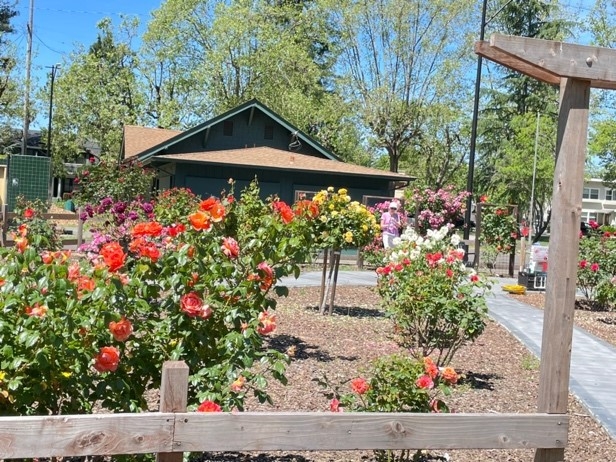
August in the Master Gardener's Rose Cycle chart (https://napamg.ucanr.edu/files/254549.pdf) indicates we have a lot of deadheading to do on our 50 bushes. In addition, ideally we should add some fresh mulch around the trunk out to the drip line of the bush. The drip line being the widest area below where the branches can reach. A well decomposed mulch, spread lightly over that area, will nourish the bush for several months. Mulch will cool the soil, retain moisture, reduce weed growth,and will fully decompose.
Deadheading encourages the rose to continue producing buds and color for the next couple of months. Keeping the center of the bushes open to air circulation is a must. Dying canes or crossing stems should be cleared out, as well. Check the irritation systems for the proper amount of water provided and to make sure there are no leaks or breaks in the system.
You will see more pests in the rose bushes this time of year. Aphids are a very common soft bodied problem. In low populations, aphids can be dealt with easily and effectively by washing aphids off your plants with a blast of plain water from the hose or just ignored. A dense infestation of aphids can treated with an insecticidal soap spray. The soap covers and smothers the soft body pest. Or for a quick kill you can rub them between your fingers (FYI: always wear gloves in the rose garden). You could also just be patient and let natural predators control them. Local natural enemies include lacewings, soldier beetles, lady beetles, earwigs and small parasitic wasps. Source: https://ipm.ucanr.edu/natural-enemies/
ROSE of the MONTH: The “LIVIN' EASY”
The “Livin' Easy” is one of the most productive roses in the garden. It is also known as “Harwelcome” in some circles. It was developed in England in 1992. It is a floribunda with a moderate fruit/sweet smell. It is a pale orange or dark apricot color, the backs are slightly paler and the center is more yellow. It has copious blooms most of the year. It is notable in our garden in that is one of the largest bushes that also has massive thorns. Sniff, but not too close is a wise approach to this bush. It is located near the water fountain in the SE corner of the garden.
Remember when pruning to toss that plant debris into your city compost bin and NOT your own compost pile. The Napa City compost center produces higher temperatures to destroy the spores while your backyard pile will not do so. When it comes to add mulch, consider getting it from the Napa recycling center.
If you have questions about the Fuller Park Rose Garden and the Master Gardeners (M.G.s) who maintain that Rose Garden, the M.G.'s are usually in the Garden the first Sunday and third Thursday of each month between 10:00 and 12:00, weather permitting.
Napa Master Gardeners are available to answer garden questions by email: mastergardeners@countyofnapa.org. or phone at 707-253-4143. Volunteers will get back to you after they research answers to your questions. You can also go to our Master Gardner website: napamg.ucanr.edu for more details.
Photo Credits: Bob Niklewicz

